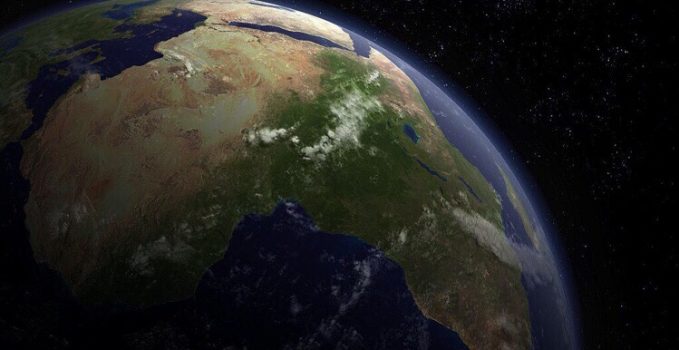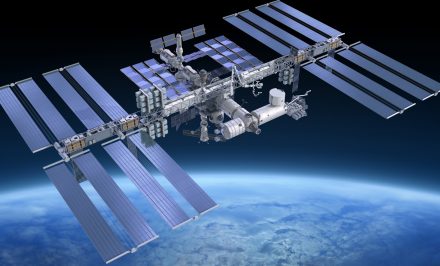The continent is ravaged with civil wars, disease, poverty and starvation, but Africa is using space programs more and more to combat those problems. Several countries have launched initiatives to use satellite technology and have set up astronomy programs. Let’s take a look at all space initiatives of ‘the forgotten continent’.
South Africa
By far the country with the largest space program on the continent. South Africa has a large and active space sector which is both government and privately funded. The country utilizes several satellites for remote sensing purposes such as monitoring droughts and disasters, as well as performing environmental studies and scientific research.
Besides that, South Africa is the main contributor to the Square Kilometre Array, the world’s radio telescope system.
South Africa has its own space agency since December 2010, called SANSA (South African National Space Agency). The agency’s purpose is to use data obtained from both domestic and international satellites to prevent disasters and perform scientific research.
South Africa is also the only country to have an actual astronaut (or ‘afronaut’ as the search of African spacemen is sometimes called): Mark Shuttleworth. Despite being aptly named, Shuttleworth flew on a Soyuz to the International Space Station. As a member of flight TM-34, Shuttleworth spent 8 days on the space station in 2002. He was cheating a bit as ‘the first African astronaut’, since Shuttleworth paid Russia approximately 20 million dollars for the trip, making him the world’s first ‘space tourist’.
Read more: Is there a future for commercial space tourism?
Telescope
South Africa is the main participant for the Square Kilometre Array, a multi radio telescope project built in both South Africa and Australia. SA isn’t the only country to host the telescope; several smaller arrays will be placed in Botswana, Ghana, Kenya, Madagascar, Mauritius, Mozambique, Namibia and Zambia.
Satellites:
| Name: | Launched: | Built by: | Purpose: |
| SUNSAT (Stellenbosch UNiversity SATellite) | 23 February 1999 aboard a Delta II rocket from Vandenberg Air Force Base | Students from the University of Stellenbosch | Mini cube-sat built by a team of students that contains several communication and remote sensors. It’s mostly used as an experimental satellite to test technologies and satellite control – knowledge which would eventually be used in other South African satellites. |
| SumbandilaSat | 17 September 2009, aboard a Soyuz Fregat rocket from Baikonur Cosmodrome | Second micro-satellite for the country, built again by students from the University of Stellenbosch together with SunSpace and the South African Council for Scientific and Industrial Research. Mostly used to experiment for control capabilities to advance the South African space program, but SumbandilaSat also gathers data used for monitoring disasters like flooding and forest fires. |
Egypt
Egypt is one of the countries that wants to build a general African space agency. It teamed up with neighbouring Sudan to start several programs, but not much has come of it so far. Other that that, the country has used its satellites for ground analysis, mostly in the Nile-region for agricultural purposes.
| Name: | Launched: | Built by: | Purpose: |
| EgyptSat 1, or MisrSat 1 | 17 April 2007, Baikonur Cosmodrome (Kazachstan) aboard Dnepr Rocket. | Egypt’s ‘National Authority for Remote Sensing and Space Sciences’, together with Yuzhnoye Design in Ukraine | Remote sensing Earth observation satelite with an infrared and multi-spectrum sensor that’s used for doing ground analysis. The satellite lost it’s S-Band communication, making Egypt lose contact with EgyptSat on 19 July 2010. |
| EgyptSat 2 | 26 April 2014 aboard a Soyuz-U from Baikonur Cosmodrome | RSC Energia (Russia) and NARSS | The replacement for EgyptSat-1 had pretty much the same goal of observing Egypt’s mainland and coasts, but its technology was far more advanced. The satellite takes high resolution images of the ground for environmental, scientific and military goals. |
| NileSat 101 | 28 April 1998 aboard Ariane 4 from Kourou, French Guiana | Matra Marconi Space (Astrium) | Telecom satelite that broadcastss television and radio signals to North Africa, South Africa, and the Middle East. |
| NileSat 103 | 17 August 2000 | The NileSat program consists of a constellation of satellites that monitors drougt levels in the Nile-region. | |
Nigeria
The less obvious country on the list is Nigeria, which has a surprisingly advanced space program. The country has so far launched five self made satellites, which are used for a variety of tasks. The country established its own space agency, the National Space Research and Development Agency, which is part of the Ministery of Science and Technology and concerns itself with coordinating the country’s space efforts. The agency was founded in 2001.
The country’s satellites were mainly used for agricultural and environmental issues. Satellites observe the massive Niger delta, and are used to help farmers find out where to plant certain crops.
Another important aspect is safety. In 2012, the country pointed its satellites toward the vast jungles in the Northwest to locate terrorists from the separatist Boko Haram movement. The satellites are also used for disaster control, for instance during flooding of the previously mentioned delta.
Better yet, NigSat-1 flew over America in 2005 when hurricane Katrina hit the coast. The United States used data from NigSat-1 during the rescue. The same happened with disasters in Australia in 2006, as well as flooding in 2014 in neighbouring countries.
There have been plans to send a Nigerian astronaut to space. The country has been talking to Russia about this, as well as with China, but nothing concrete has yet come of it.
Satellites:
| Name: | Launched: | Built by: | Purpose: |
| Nigeriasat-1 | 27 september 2003 | Surrey Space Technology (UK) | Part of the international Disaster Monitoring Constellation System, NigeriaSat-1 is used to prevent natural disasters and do research on desertification in the North of the country. NigSat-1 is also used to do demographic planning.
|
| NigeriaSat-2 | 17 August 2011 | Surrey Space Technology | Same as NigeriaSat-1, NigSat-2 was part of the DMCII system and helped prevent disasters in the area. It had a higer resolution that its predecessor though, and was launched from China. |
| NigComSat-1 | 13 may 2007, Xichang Launch Centre (China) | NASDRA | Nigeria first telecommunications satellite is designed to provide phone, television and internet coverege through a large part of middle Africa. After 19 months in orbit, the satellite was shut down due to a lack of power, caused by a faulty solar panel. It was switched off on 11 november 2008. |
| NigComSat-1R | 19 December 2011 from Xichang Launch Centre (China) | The obvious replacement for NigComSat-1, meant to take over where the previous satellite had stopped. Same as with the first satellite, NigComSat-1R uses a DFH-4-band to bring telecommunications to a large part of Africa. |
Algeria
Algeria has had an official space agency since 2002, pragmatically named the Algerian Space Agency (ASAL for short, or الوكالة الفضائية الجزائرية in Arabic). ASAL advises the government on its space strategy, which currently consists mostly of its 4 satellites and several research facilities and a telecommunications centre.
As one of the largest countries on the continent, Algeria has many needs for observational satellites, and its space agency’s endgoal is to launch 10 satellites by 2017 that will “put space technology at the service of social and economic development of the country.”
The country is very internationally oriented in its space policy. Over the past years, Algeria has signed agreements and treaties with the Argentinian space agency as well as France (CNES) and Ukraine (NSAU), Russia, China, and the UK.
Satellites:
| Name: | Launched: | Built by: | Purpose: |
| Alsat-1 | 28 November 2002, aboard a Kosmos-3M rocket from Plesetsk Cosmodrome (Russia) | SSTL | Micro-satellite that was built as part of the international Disaster Monitoring Constellation. The satellite took medium resolution multispectral images of natural disasters. These images were later used for remote sensing purposes. |
Ghana
Ghana’s space program is one of the youngest of all African countries, only having been founded in May 2012. As such, it’s still in its infancy and has made only little progress, though the country’s ambitions are big. Current, Ghana has the Ghana Space Science and Technology Center as its central coordinating body for all space activities in the country. The GSSTC coordinates research across the country in several areas such as remote sensing and satellite communications.
The country hasn’t yet launched its own satellite, though it aims to in 2018. Ghana wants to launch a cube-sat in that year, though it’s still in very early development and even its actual goal is not entirely clear.
Kenya
Kenya has been talking about creating a national space agency for almost 3 decades, but has only actual done so in 2016. The country formed the Kenya Space Agency on February 18 of this year, simultaneously signing the ‘Kenya Space Policy and Strategy’, a roadmap for the country’s space activities for the coming years.
But despite the country’s ambition and it’s close proximity to the equator, there are few initiatives in the country other than the wish to ‘launch a constellation of satellites’ somewhere in the coming years.
The country does have its own spaceport, the Luigi Broglio Space Centre near Malindi, but this is Italian-owned and has’t been in use since 1988.
Ethiopia
Ethiopia doesn’t have a national space agency, yet the country is investing in its space sector through privately funded initiatives. Its major one is an astronomical observatory which has been set up in August 2015. The observatory was privately funded by Ethiopian-Saudi businessman Mohammed Alamoudi, and cost about 3 billion dollars, of which Ethiopia itself didn’t contribute anything.
Nevertheless, the observatory has been training amateur and professional astronomers of the Ethiopian Space Science Society which is privately funded as well.
Ultimately, the Society and the Ethiopian Institute of Technology wish to use the knowledge to establish a national space agency. Members of the institute even hinted at “the launch of Ethiopia’s own rocket” within the next 5 years – though that might be slightly ambitious. Earth observation satellites are in the works as well.
Tags : .space, africa, astronomie, astronomy, cube sats, egypt, ethiopia, ghana, kenya, nigeria, ruimtevaart, satelites, SKA, south africa, square kilometre array, telescope



